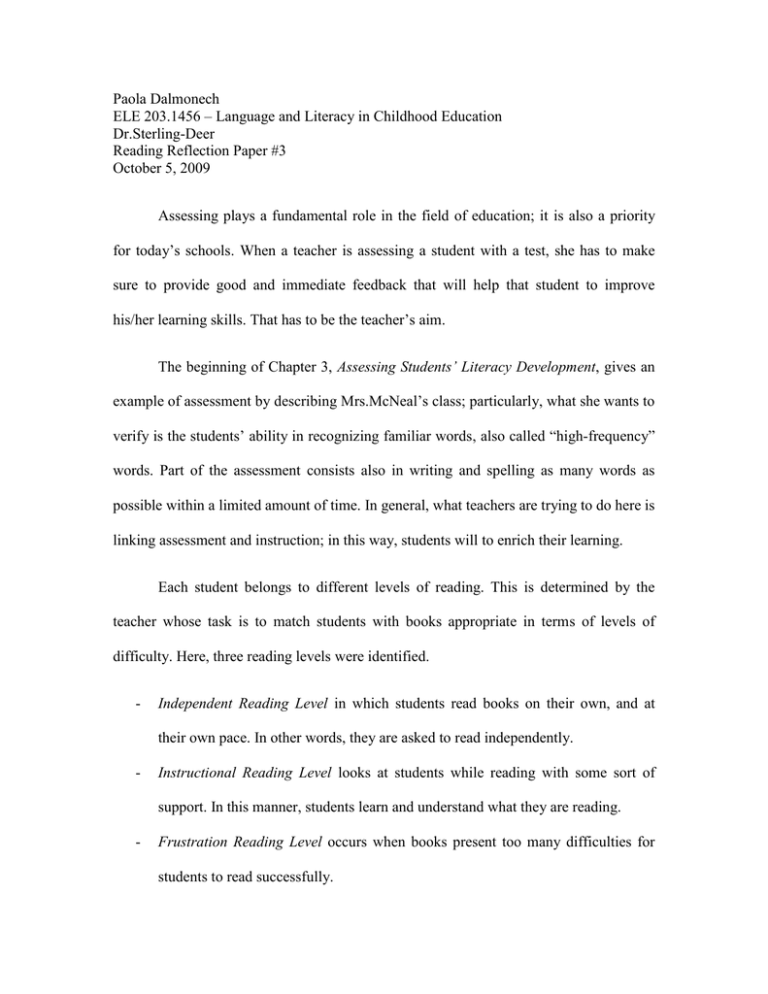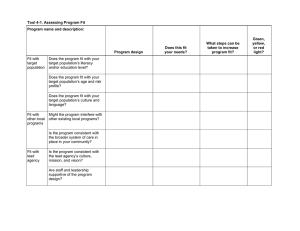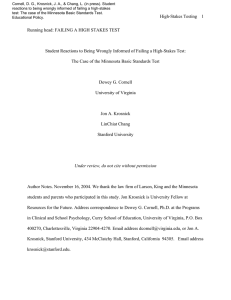Paola Dalmonech ELE 203.1456 – Language and Literacy in Childhood Education Dr.Sterling-Deer
advertisement

Paola Dalmonech ELE 203.1456 – Language and Literacy in Childhood Education Dr.Sterling-Deer Reading Reflection Paper #3 October 5, 2009 Assessing plays a fundamental role in the field of education; it is also a priority for today’s schools. When a teacher is assessing a student with a test, she has to make sure to provide good and immediate feedback that will help that student to improve his/her learning skills. That has to be the teacher’s aim. The beginning of Chapter 3, Assessing Students’ Literacy Development, gives an example of assessment by describing Mrs.McNeal’s class; particularly, what she wants to verify is the students’ ability in recognizing familiar words, also called “high-frequency” words. Part of the assessment consists also in writing and spelling as many words as possible within a limited amount of time. In general, what teachers are trying to do here is linking assessment and instruction; in this way, students will to enrich their learning. Each student belongs to different levels of reading. This is determined by the teacher whose task is to match students with books appropriate in terms of levels of difficulty. Here, three reading levels were identified. - Independent Reading Level in which students read books on their own, and at their own pace. In other words, they are asked to read independently. - Instructional Reading Level looks at students while reading with some sort of support. In this manner, students learn and understand what they are reading. - Frustration Reading Level occurs when books present too many difficulties for students to read successfully. One of the most popular types of assessment used by the teachers to monitor and examine students’ learning is the “leveled books” where each students’ ability in reading is classified with a particular level; alphabetical letters, from A through Z, represent the criteria used to control students’ capability in reading. Additionally, monitoring students’ progress is also very important and it should be done every single day because only in this way teachers learn about their students, and how they develop their literacy learning. To do so, teachers sometimes take short notes in notebooks after observing a student. Also, teachers conference with the child to see if improvement has occurred, and if not, the teacher had to find ways in order to help the student solve the problem. Furthermore, teachers collect students’ work in folders to document their learning; those folders are also called portfolios. By having a portfolio containing all the work done, students learn to reflect on and assess their own reading and writing activities and their development as readers and writers. Thus, portfolios represent important tools for students because they document students’ work, evaluate their progress, and eventually showcase their best work by physically demonstrating it. The whole point of having a nice and organized folder is to emphasize the improvement that one student does after the reading instruction. Towards the end of this chapter, we see how high-stakes tests are not entirely effective and linked to the goal of improving the quality of literacy instruction. In fact, a number of problems are associated with high-stakes tests. In particular, when taking the actual test, students feel the pressure; they get nervous and stressed, and consequently, they struggle and don’t try their best. They are anxious and discouraged because afraid of failing, and over time, test pressure destroys their enthusiasm in learning. Undoubtedly, this doesn’t help teachers either, who face difficulties in improving students’ test scores. However, there are several ways for teachers to prepare students to take high-stakes tests without abandoning a balanced approach to instruction. For example, there are practice tests with the same types of items used on the standardized tests, so students can focus on strategies without being challenged by the difficulty level of the questions. Hence, students are taught a list of best-taking strategies that will help them answer the questions in the best and most accurate way. For instance, reading the entire question first to make sure they understand what is asked. Pacing yourself is also an effective strategy because students will be able to finish the test managing their time wisely. And, most importantly, checking work carefully to ensure students answered every question. I believe conference is a good type of assessment for looking at students’ learning. Although it’s an informal procedure, having teachers talk with students at their desks or in groups is a valuable way of checking if there was any progress. It is important that the teacher establishes brief talks about information related to the book the students are reading. In this occasion, students can ask questions or clarifications about difficult concepts or vocabulary words that they didn’t fully comprehend. Moreover, students have the possibility to share their thoughts and discuss about their book they personally read. The teacher meets with the students to proofread compositions or any kind of written work and helps them correct spelling, punctuation… Overall, I think conferences are significant moments for students’ growth because students can easily reach their goals and accomplish what they were seeking.



